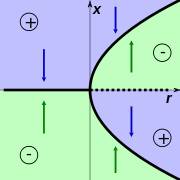Pitchfork bifurcation
In bifurcation theory, a field within mathematics, a pitchfork bifurcation is a particular type of local bifurcation. Pitchfork bifurcations, like Hopf bifurcations have two types - supercritical or subcritical.
In continuous dynamical systems described by ODEs—i.e. flows—pitchfork bifurcations occur generically in systems with symmetry.
Supercritical case

The normal form of the supercritical pitchfork bifurcation is
For negative values of , there is one stable equilibrium at . For there is an unstable equilibrium at , and two stable equilibria at .
Subcritical case

The normal form for the subcritical case is
In this case, for the equilibrium at is stable, and there are two unstable equilibria at . For the equilibrium at is unstable.
Formal definition
An ODE
described by a one parameter function with satisfying:
- (f is an odd function),
has a pitchfork bifurcation at . The form of the pitchfork is given by the sign of the third derivative:
Note that subcritical and supercritical describe the stability of the outer tines of the pitchfork (dashed or solid, respectively) and are not dependent on which direction the pitchfork faces. For example, the negative of the first ODE above, , faces the same direction as the first picture but reverses the stability.
References
- Steven Strogatz, Non-linear Dynamics and Chaos: With applications to Physics, Biology, Chemistry and Engineering, Perseus Books, 2000.
- S. Wiggins, Introduction to Applied Nonlinear Dynamical Systems and Chaos, Springer-Verlag, 1990.